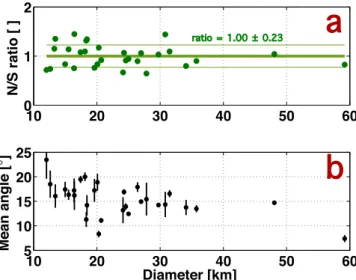Characterization of the morphometry of impact craters hosting polar deposits in Mercury's north polar region
Texte intégral
Figure




Documents relatifs
Efficacy and Safety of Flexibly Dosed Esketamine Nasal Spray Combined With a Newly Initiated Oral Antidepressant in Treatment-Resistant Depression: A Randomized
One region is within the first hinge position (Gly129 and Pro131) that anchors the uS19 C-terminal tail during the translation elongation cycle (Figures 3A and 3D). Also, muta- tion
We show an aberrant pattern of laminin organization in the extracellular matrix of the myocardium as one of the earliest defects in Nmrk2-KO mice, suggesting a conserved function
Prata, A. A., Stohl, A., and Kerkmann, J.: Long range transport and fate of a stratospheric volcanic cloud from Soufriere Hills volcano, Montserrat, Atmos.. Carn et al. Title
observed to be greater than 1.0 on a few occasions which highlights that the MPB community might have suffered from occasional light limitation. Howver, as the PAM readings
With these very low exposure rates, and given the short periods of time that personnel are located near the source, the dose to animal care personnel is substantially below levels
Coupling clay swelling properties to hydro- geochemical conditions: a reactive transport modeling approach... Coupling clay swelling properties to hydro-geochemical conditions:
1: Particle size distribution of the soil sample Fibres were obtained from three different agricultural wastes (sugarcane residue ‘bagasse’, coconut husk and oil
![Table 3. Power Law Fits for Four Crater Morphological Types Defined by Pike [1988]](https://thumb-eu.123doks.com/thumbv2/123doknet/14249818.488056/10.887.218.671.101.464/table-power-fits-crater-morphological-types-defined-pike.webp)
